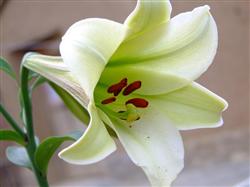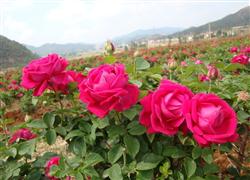Softwood Cuttage technique of Purple Branch Rose in Summer

Purple rose cuttings can be divided into summer cuttings and winter cuttings according to the time, and softwood cuttings and hardwood cuttings are divided into softwood cuttings and hardwood cuttings according to the maturity of branches. Of course, hardwood cuttings can also be carried out in spring and autumn, but they are not used. Because spring branches act as the task of flowering, cutting affects the yield and ornamental value of flowers, while the growth of autumn cuttings is almost the same as that of cuttings in winter greenhouse, but autumn cuttings need to be managed for a few more months, which is both time-consuming and laborious. and take up a few more months of land. Full-light spray method is often used to raise seedlings by softwood cutting in summer, and the cutting time is mostly from mid-June to mid-August, depending on the growth status of local seedlings. The first is the construction of the seedbed. Nursery bed to choose ventilation, no building shelter, convenient access to water and electricity, the size of the seedbed should be determined according to the number of seedlings propagated, the width is more than 1.5 meters, and the length is self-determined according to the situation. First of all, lay a layer of brick on the ground, fence barrier 3 or 4 layers of brick: the matrix can choose frogstone or river sand, disinfect the substrate about 10 days before cutting, can use 0.3% potassium permanganate solution. Lay the matrix flat on the slotting bed with a thickness of about 30 cm. Install the sprinkler, the number of the sprinkler depends on the spray pressure, which is the key to the technology. Because full-light spray cutting seedlings is in the open-air seedlings, with regular water spraying method to ensure that the substrate is moist. The fog emitted by the installed sprinkler should ensure that the seedbed is completely covered and there is no dead corner. If propagated in a small amount, it can be cut in a nutrition bowl. The second is to choose cuttings. The cuttings should be cut from the middle, upper and outer parts of the rose bushes, cut the top tips of the semi-lignified vegetative branches of the same year, then cut into cuttings 10 to 15 centimeters long, cut the lower end obliquely, cut the upper end flat, leave one or two pairs of accessory leaves in the upper part, and remove all the leaves in the lower half. Immediately after cutting, put it in a basin filled with water to prevent water loss and withering (figure 1). If cutting at flowering stage, it is best to choose vegetative branches without buds and flowers. After the cuttings are cut, insert them in the substrate on the same day, not overnight. The depth is 2-3 cm, too shallow is easy to lodge, too deep is easy to mildew. The density is about 600 square meters, if it is too dense, the ventilation is not good, which affects the growth, and if it is too thin, it is a waste of space. The third is to spray water immediately after maintenance and management, replenish leaf moisture, and at the same time make cuttings closely connected with seedling bed, and the spraying and interval time can be adjusted at any time according to weather temperature and moisture of leaf water matrix. As long as there are water droplets in leaves, the amount of spraying water should be reduced as far as possible without leaf wilting, so as to improve the ground temperature, which is conducive to root growth and reduce the occurrence of diseases. When the temperature exceeds 30 ℃, it is necessary to appropriately increase the number of water spraying: some fertilizers can be added to the water, mixed into a nutrient solution, and sprayed regularly. Weeds should also be removed in time to ensure that the seedlings take root smoothly. By about 20 days, the rooting rate can reach more than 85%. At 25-35 days, the seedlings grow whisker roots, the roots are stout and darker, then gradually reduce the amount of spraying water, only spray water at high temperature at noon, refine the seedlings, and transplant in 5-7 days. Finally, transplanting. Choose cloudy days or transplant sooner or later, pour the seedling bed with water before transplanting, so that the bed surface is soft, so as not to damage the root system. The seedlings were dug out with a shovel and gently shaken off the matrix. The plant spacing was 10-15 cm and the row spacing was 30-40 cm. Water immediately after planting, and then irrigate 2-3 times continuously. After slowing down the seedlings, weed and loosen the soil in time to ensure that the rose seedlings thrive.
- Prev

Large area planting technique of Rose
Now many netizens have planted lilies or sent lilies to relatives and friends. Today, I would like to introduce the symbolic significance and characteristics of lilies: Lily is a world-famous flower that has been loved since ancient times. Origin and distribution: temperate regions such as China, Japan, North America and Europe. Lilium is a perennial herb.
- Next

How to prevent roses from rotting?
The production of pollution-free edible roses, the prevention of diseases and insect pests and the maintenance of healthy rose plants is the best way to control diseases. Usually take the following preventive measures: 1. Select disease-resistant strains and use healthy plants as seedlings. 2. Avoid applying too much nitrogen fertilizer, lest the plant will not grow strong enough.
Related
- Fuxing push coffee new agricultural production and marketing class: lack of small-scale processing plants
- Jujube rice field leisure farm deep ploughing Yilan for five years to create a space for organic food and play
- Nongyu Farm-A trial of organic papaya for brave women with advanced technology
- Four points for attention in the prevention and control of diseases and insect pests of edible fungi
- How to add nutrient solution to Edible Fungi
- Is there any good way to control edible fungus mites?
- Open Inoculation Technology of Edible Fungi
- Is there any clever way to use fertilizer for edible fungus in winter?
- What agents are used to kill the pathogens of edible fungi in the mushroom shed?
- Rapid drying of Edible Fungi

